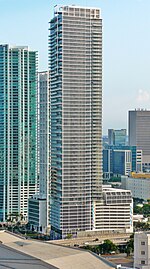Museum Park station
1994 establishments in FloridaMetromover stationsOmni LoopRailway stations closed in 1996Railway stations in the United States closed in the 1990s ... and 2 more
Railway stations in the United States opened in 1994Railway stations in the United States opened in 2013

Museum Park is a Metromover station located on the southeast corner of Biscayne Boulevard and I-395 in Miami, Florida. Originally opened as Bicentennial Park in 1994 and closed in 1996, the station reopened with the completion of the Pérez Art Museum Miami at the newly renamed eponymous park in 2013. The station is located near the intersection of Biscayne Boulevard (US 1) and Northeast 11th Street, adjacent to the MacArthur Causeway (I-395/Florida A1A).
Excerpt from the Wikipedia article Museum Park station (License: CC BY-SA 3.0, Authors, Images).Museum Park station
Biscayne Boulevard, Miami
Geographical coordinates (GPS) Address Nearby Places Show on map
Geographical coordinates (GPS)
| Latitude | Longitude |
|---|---|
| N 25.785833333333 ° | E -80.187777777778 ° |
Address
Patricia and Phillip Frost Museum of Science
Biscayne Boulevard 1101
33132 Miami
Florida, United States
Open on Google Maps









